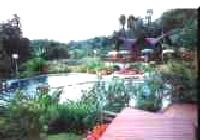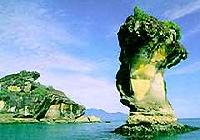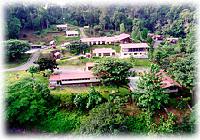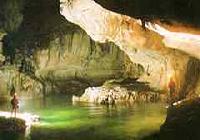This was a tip from e-borneo.com's "residence" orang utan, Raj, on the above subject, which was published on one of our previous newsletters:
For my first proper advise/tip, Its not really surprising that I am going to touch on something that I know better than most humans. Well, if you are an orangutan lover and like to pay us a visit/observe what we are really like close-up and personal in our natural habitat, the tropical rainforest, there are two popular destinations where you can do just that in Malaysia Borneo - at the Sepilok Orangutan Rehabilitation Centre in Sandakan, Sabah, and at the Semenggoh Orangutan and Wildlife Sanctuary in Kuching, Sarawak.
However, one of the most common queries a visitor would ask is which is the better place to visit. Simple really, if your trip only allows you to stay in only one state (either Sabah or Sarawak), then you don't really have much choice, do you? Both has its own uniqueness. But, if you have the luxury to choose, hmmm, I would personally recommend Sepilok. Not that I'm bias since it's my little hometown but it just that you will be more likely to meet at least one of us there compared to Semenggoh.
Firstly, Semenggoh is not as visitor-friendly and well developed as Sepilok - the feeding platform is not as sophisticated as the ones at Sepilok. The sanctuary is actually a temporary home for various endangered wildlife of Sarawak, especially the Orangutans which have been rescued from captivity. Secondly, there is not that many Orangutans nowadays there compared to Sepilok. Maybe my cousins in Semenggoh are much more evasive than us here in Sandakan? Maybe, we are simply not as shy as them? Nah, I think this shows that they are adapting very well to the wild habitat of Semenggoh nowadays and have left the sanctuary into the deeper rainforest.
And contrary to how it used to be, there is no more scheduled feeding time for them (supposedly the highlight of this type of tour), so now they only come to the centre when wild foods are scarce, for example during the low-fruiting season. With the inconsistent visits, there is no more guarantee that visitors will see orangutans mingling about in the centre. Anyway, during the high-fruiting season, you will be lucky to see even one orangutan at Semenggoh although you can still hear them 'sing'. Apparently, according to Sibangau, my second cousin there, although they would have like to come down to the feeding station when they are lots of tourists (normally during their normal feeding times), they have had so much to eat already that they just couldn't move. Don't quote me on that. That's what Sibangau told me!
Sepilok is different. During the fruiting period, I remembered that although we were pretty full, we still put on a show for the tourists..., with some fake bananas. After all, Sepilok is a world-famous rehabilitation centre for goodness sake. Hence, it is better organised for tourism purposes. But, I must mention that in recent times, the number of Orangutans there have declined. Like Semenggoh, many of us have graduated, or like what you humans like to say, rehabilitated. Hey, I'm one of the success product of the centre you know. I'm the first orangutan to be 'employed' as a virtual guide to an Internet website, and now, a contributor to this newsletter.
Ok, enough about me. At Sepilok, you can walk along a raised wooden platform to witness my mates swing in from the jungle on to the specially-designed feeding stations during feeding time. There are two standard feeding time daily at 10:00am and at 2:30pm. Sometimes, it feels more like a zoo than anything else before and during the feeding, but if you wait until the centre is less crowded, you might get a surprise visit from my curious friends. This seldom happens at Semenggoh.
Sorry Semenggoh..., I guess I'm just plain bias after all (:@P
Anyway, both Sepilok and Semenggoh are interesting places to visit. Sepilok may be more 'sophisticated' for tourists, but Semenggoh allows visitors to be right in the middle of the forest to catch a glimpse of my kind and to witness their feeding. More info refer to the webpages below:
For hardcore orangutan lovers, I know of a one-of-a-kind package deal where you will have the rare opportunity to get real close to an orangutan - that is if they don't outsmart you. Check out the following URL for the "In Search of Borneo Wild (huh?) Orangutans at Jingin, Sarawak" special package:
Hey, I've not forgotten Kalimantan, the Indonesian Borneo. The best spots if you happen to be there is likely to be at Wanariset Orangutan Rehabilitation Centre in East Kalimantan, Gunung Palung Orangutan Conservation Project in West Kalimantan, and Nyaru Menteng Orangutan Rehabilitation Center in Central Kalimantan. For more info at the URLs below:
I seriously don't think these places are part of any tour packages as they are essentially projects/centers for orangutan research and reintroduction run by an independent US non-profit organisation called BOS-USA. But you probably can do a self-guided tour there and pay them a fee/donation. This is just my idea, ok? Better email them first ( cmallar@orangutan.com ). For your info, BOS-USA was formed to support orangutan conservation and to raise awareness of the plight of the orangutan. They also support the Kinabatangan Orangutan Conservation Project (Project HUTAN) in Sabah. Bless them. So, if you do go there, make an effort to dig deep into your pocket and give them something. Tell them 'Raj' sent you, ok? Better still, you can actually donate online at their website ( http://www.orangutan.com/ ). Copyright © 2004 e-borneo.com





